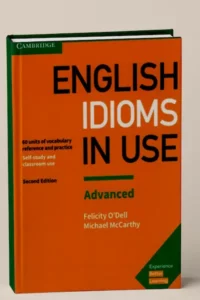English Idioms in Use Advanced will help you to Improve your understanding of idioms in English and provide you with explanations and practice of English idioms for advanced level.
Also Read: English Idioms in Use Intermediate
English Idioms in Use Advanced 2017 pdf:
English Idioms in Use Advanced Improve your understanding of idioms in English. Explanations and practice of English idioms, written for advanced-level (C1 to C2) learners of English. Perfect for both self-study and classroom activities. Learn idioms in context, with lots of different topics, including ‘Learning’, ‘Formal writing’, and ‘Telling stories’.
Be confident about what you are learning, thanks to Cambridge research into how English is really spoken and written, and get better at studying by yourself, with study tips, follow-up tasks and an easy to use answer key.
Why was this book written?
It was written to help you take your knowledge of idioms to a more advanced level. The ability to use idioms accurately and appropriately is an indicator that you have a truly advanced level of English, and so this book pays attention to the productive use of idioms as well as to the comprehension of their meaning.
Many of you will have already worked with English Idioms in Use Intermediate, and this book builds on the work done there. However, it does not matter if you have gained your knowledge of idioms in a different way. We do not assume that you have used English idioms in Use Intermediate, although we do present and practise different idioms from those that were presented in the lower-level book.
Also Read: English Verbs
How were the idioms in this book selected?
The idioms which are presented in this book were mainly selected from those identified as significant by the CANCODE corpus of spoken English, developed at the University of Nottingham in association with Cambridge University Press, and the Cambridge International Corpus of written and spoken English (now known as the Cambridge English Corpus).
The idioms selected are all also to be found in the Cambridge Advanced Learner’s Dictionary 4th Edition, where you can find additional usage notes and examples.
How is the book organised?
The book has 60 two-page units. The left-hand page explains the idioms that are presented in the unit. You will usually find an explanation of the meaning of the idiom, an example of it in use, and, where appropriate, some comments on when and how it is used. The exercises on the right-hand page check that you have understood the information on the left-hand page and give you practice in using the material presented.
The units are organised into seven sections:
- Learning about idioms (Units 1-8) gives important information relating to idioms in general, such as what they are and how to use them accurately.
- Types of idiom (Units 9-13) looks at some different types of idiom, dealing with such areas as Similes and idioms from other languages.
- Idioms from the topic area of … (Units 14-24) focuses on idioms originating from different topic areas. For example, a great many idioms in English are based on sailing, a result of Britain’s history as an island with a strong dependence on the sea. This section therefore opens with a unit dealing with idioms originating from the topic area of Sailing. Other units in this section deal with, for example, idioms based on Parts of the body, Games and sport and Literature. Many of us find it interesting to learn about the origins of idioms, and studying them in this way can also help to fix their meaning in your memory.
- Idioms to talk about … (Units 25-38) focuses on the topic areas where certain idioms are frequently used. For instance, there are units dealing with idioms used when talking about Money, about Society, or about Problems.
- Idioms used in … (Units 39-41) looks at three types of writing where distinct types of idioms are used – Journalism, Advertising and Formal writing.
- Idioms used in conversation (Units 42-47) presents idioms used in conversations from a functional point of view. For example, there are units dealing with Telling stories, Agreeing and disagreeing and Emphasising.
- Idioms using these keywords (Units 48-60) groups idioms according to the keywords that they centre on. Unit 53, for instance, presents and practises idioms using the word hand, while Unit 59 focuses on idioms using the verb fall.
- The book also contains a key and an index, listing the idioms we deal with and indicating the units where they can be found.
Also Read: All Cambridge IELTS Books
How should I use this book?
We strongly recommend that you do the first two units in the book first – What are idioms? and When and how are idioms used? – as these give you basic information that underpins all the other units. After that, you may work on the units in any order that you prefer.
What else do I need in order to work with this book?
You need a notebook or file so that you can write down the idioms that you study in the book as well as any others that you come across elsewhere. You also need to have access to a good dictionary. We strongly recommend the Cambridge Advanced Learner’s Dictionary, as this gives you exactly the kind of information that you need to have about idioms.
Your teacher, however, may also be able to recommend other dictionaries that you may find useful. So all that remains is to say if you want to stand out from the crowd (Unit 40), start studying the idioms in this book. There’s no time like the present! (Unit 40). We hope you’ll find this an enjoyable and useful way to keep up and extend your knowledge of English idioms in use.
Also Read: Oxford Dictionary Idioms

